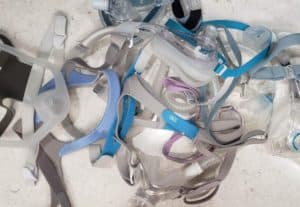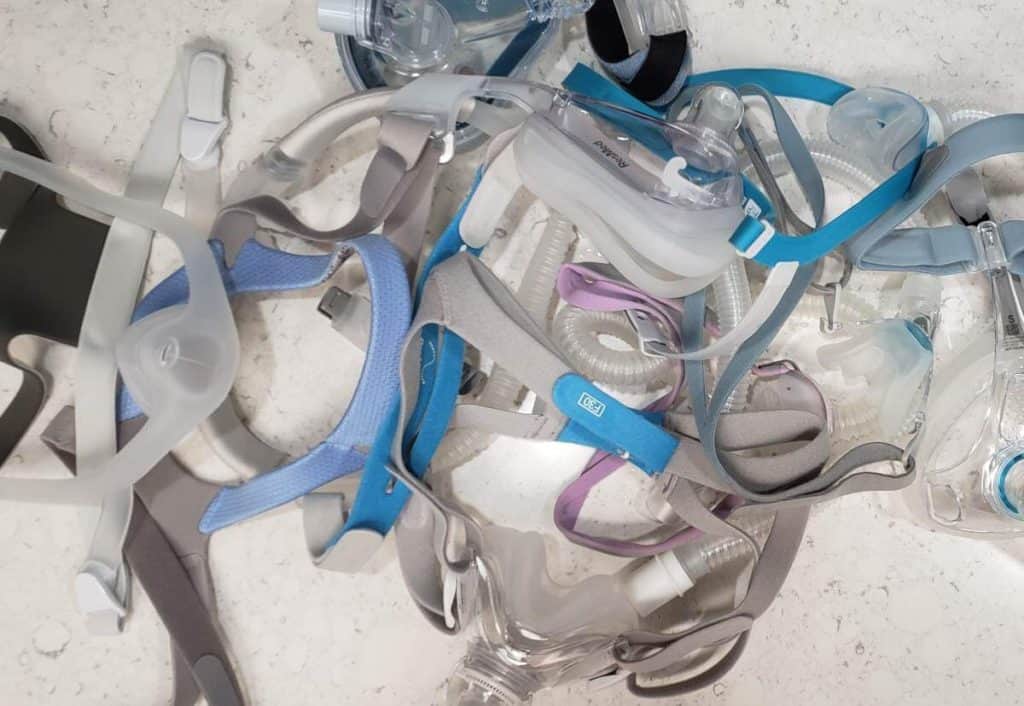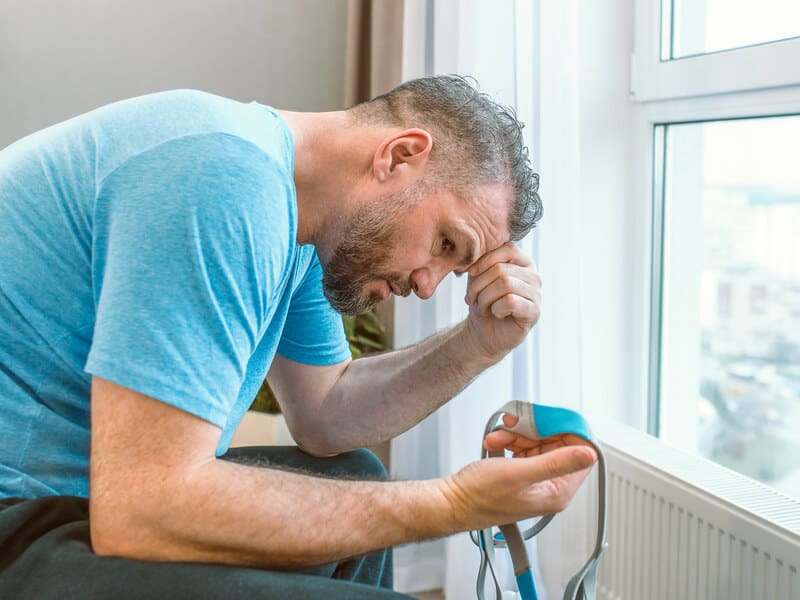
How do you know if the CPAP mask you are using is the right or wrong mask for you?
Are you experiencing difficulties with your CPAP mask? Finding the right mask is crucial to achieving the benefits of using CPAP therapy.
Did the mask feel fine when you first got it, and now it has started to hurt?
Let’s say the first few nights when you put the mask on. It wasn’t too bad. You were able to get a few hours in before you woke and took it off.
You need to start narrowing down the cause of the change and problem.
1. Is the air cold
2. Your mouth is too dry
3. The mask hurts your face
4. You’re waking as you move through the night
5. Air is leaking all over the place or it’s making a lot of noise
These are the most common complaints. Of course, you may have different or more to add to the list. You must track these, and keep a note of the first thought you had when you woke. If you wake up because you have to use the restroom that is a pressure thing or medication. Not the mask.
The air is too cold/Your mouth is dry
I find these issues to be most common with women. As the weather in your bedroom changes, so does the need for changing what’s going on with the cpap. This can mean changing the setting of the heat and humidification on your pap. Not all brands have a heated hose if yours does use it. I also wrap my hose, ensuring the ambient air is not hitting it. You can do this with thick socks cutting the toes off them and threading them onto the hose. Or make a hose cover of thick blanket fleece. I did this; it’s lighter, and I sew. All of the ones on the market currently are too thin. If I find a good supplier, I will add it to this post. (You can send me an email, and I’ll let you know). The next thing to try is a full face mask. I know I can hear the groans now. But actually, they are easier to use.
When I mention a full face mask most of the time people complain. It’s bigger maybe even scary. All kinds of reasons why they can’t use them. But everyone that has changed has felt better. Each manufacturer now makes a minimal full-face mask. Which comes under the nose not all the way to the bridge. These work ok for most. But if you have a wide nose or you tend to sleep a lot on your side you may find the traditional full face easier to get used to.
The mask hurts or is causing a rash
A. Are you washing the mask every morning? The movement of a dirty mask can cause a rash and sometimes pain. When you take the mask off, put it in a bowl of water with a few drops of dishwashing liquid. Soak for 5 minutes and rinse, and you are ready to go for the night.
B. Make sure you are not wearing face cream. Sorry. Again this will cause the mask to move through the night and lift a bit off your face causing leaking.
Using the correct pillow and size is often more important than the mask.
Are your cheekbones sore in the morning? Are you sleeping on your side, or are your straps too tight? Go through the process of adjusting the clean mask again. Next, where is your pillow?
You want to use a small about 6×12 pillow. Sleep with it back by your ear, and keep the pillow behind the side of your face. This does two things, first stops the friction of the strap and pillow, and it also stops the movement of the mask on your face and slows down the air leakage. I buy one at the drugstore for about $20, divide it in half by sewing a couple of seams right in the middle of the pillow, and cut it in half. Now I have two for the price of one.
Pain and discomfort
Pain/discomfort: If your mask is causing you discomfort or pain, try to identify where it hurts. Is it the bridge of your nose or the cheekbones?
A. How tight is your mask? When you are on your back, are you able to pull the mask off your face about 1/4 inch? If not, loosen it, snug down the top straps first so that no air is in your eyes, and then the bottom strap. Air will leak a bit down your laugh lines.
B. Bridge of the nose: If you have a wider bridge, consider masks produced by Fisher & Paykel, as they fit more comfortably. Alternatively, try a minimal contact mask. ResMed F30, a full-face mask, is a good option as it best hugs the bottom of the nose.
C. Cheekbones: If the strap holding the mask to your face is running on top of your cheekbone and hurts in the morning, use a small buckwheat pillow for neck support. Keep your pillows and hands by your ear. This allows the mask and straps to be free of pressure.
I can’t wear it for 8 hours
Are you finding it hard to keep it on for a full night? If you find yourself taking the mask off during the night, that’s fine. You need to wear it to ensure you give your body enough time to adjust. This is hours, not minutes. Some folks put on the mask, and it’s like the best thing ever; this tends to be people with severe sleep apnea. For most, however, that is not the case. It may take weeks. Wearing the mask throughout the night is essential for identifying and fixing any problems. This is not a one-and-done process. Each time you try something different, your body will go through an adjustment period. It’s much easier to find a mask that fits without pain and work each problem as they come.
How many hours did you try each night? Did you really try, or did you just put it on and remove it immediately? By keeping it on throughout the night, that’s when the real problems come up, and we can work them out. Few people wear a CPAP mask and think it’s the best thing ever. So get over thinking it’s going to feel perfect.
You often haven’t given your body enough time to adjust to wearing the mask. For some, it takes several weeks for the sub-conscience mind to calm the conscience mind into everything is fine. Others with severe sleep apnea seem to adjust right away. Their body seems to know it’s this or die.
Let’s say you’ve used it through the night for a week. But taking it off 4 hours into the night is fine. You have a good start, or better yet, you realize you took it off and put it back on. If insurance is paying for your cpap, you have met their requirement for that night. However, you are striving for a full night’s usage. The bottom line is heart health.
To summarize
When you put the mask on it should feel ok. Putting something on your face is never going to feel great, the energy and health you get from using CPAP is what is great.
*When you wake in the morning you should not have a rash if you do wash your face and mask daily.
*If you’re waking to noise, are you sleeping on your side with a large pillow? Did the oils in your face cause the mask to lift?
*Your mouth is too dry, how’s the humidity of the air? Are drinking enough water during the day or taking meds that dry you out?
When a client comes to me and says they are having problems with the mask. It’s time to do a little investigation and dig. If you are visiting with a provider and they don’t ask you questions about your issues. Leave. They should not just give you a mask because you want one. But they should be guiding the choices you make. No need to waste money, whether it be yours or the insurance companies.
Unable to tolerate the mask
Or is it you just don’t want to use CPAP? Be honest with yourself. You need to get to the bottom is it your health no matter what or is it your comfort and your health takes a backseat when it gets tough?
While CPAP is not the only way to treat sleep apnea it is the only thing at this time that works 100% to stop sleep apnea when you use it.


